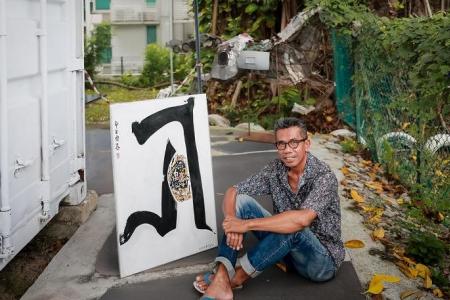Artists reinvent batik and Chinese ink traditions
Seen from afar, you might mistake Singaporean artist Sunar Sugiyou’s Wiseman (2023) for an arcane sinograph dashed off in Chinese ink.
Upon closer inspection, the illusion dissolves. The black brush strokes are in fact a mix of Chinese ink, acrylic and latex – set against a canvas and not rice paper. At the edge of these “brush strokes” are almost invisible Javanese spiral motifs.
The 62-year-old artist, who has worked with Chinese ink for the past 24 years, is only mimicking the medium. Beyond representational ink works of a Chinatown market or the Singapore River, which are remarkably vivid, Sunar reveals a more experimental and abstract side in his latest Cosmology series.
“The masters already perfected the strokes 5,000 years ago, why should I do the same?” asks Sunar, who says that working in the medium as a non-Chinese and self-taught Chinese ink artist has given him latitude to break from tradition.
“They excuse me,” he says with a laugh, although he adds that his works have often been mistaken as those of a Chinese artist’s.
Sunar and veteran batik artist Sujak Rahman are exhibiting new work as part of After Tradition, which explores how the boundaries of traditional forms are being pushed in their practice. The show will also include work by the late batik artist and Cultural Medallion recipient Sarkasi Said, also known by his artist name Tzee, who died in 2021.
Sujak and Sunar will conduct an experiential workshop ($20 for general admission, $16 for students and seniors) that delves into their unconventional batik and Chinese ink techniques. It will be held at The Arts House.
Sunar, who is of Javanese heritage, started his Chinese ink journey by painting roosters – which woke him up for dawn prayers at the kampung he grew up in. Instead of picking up the tradition by learning to execute various plants and flowers, he simply picked up books by the Chinese masters and imitated them.
The artists he admires are, naturally, inveterate experimenters. He names Chinese artist Liu Kuo-sung – whose experimental ink works were recently shown in a retrospective at National Gallery Singapore – and Chinese-Muslim artists Yusuf Chen Jinhui and Haji Noor Deen Mi Guang Jiang.
Works from Sunar’s Cosmology series on display replicate the qualities of Chinese ink while blending it with his collage practice. Although they are largely abstract, his preoccupation is that of the “profound connection between human perception and the vastness of the universe”.
Sujak, who worked alongside Sarkasi when they ran an art studio within the handicraft shop at Wisma Indonesia in the late 1970s till 1983, questions if batik artists should be satisfied in continuing to work in traditional ways. “Indonesian housewives can do very fine batik work – can you challenge them?”
The 75-year-old has instead brought a deep interest in modern experimentation and contemporary expression to the traditional craft of batik for over 40 years of his practice.
Sujak has, for example, taken properties such as the unintended crackling effect of batik and has devised ways to control them in his work and create new effects.
He is also keen to experiment with the materials of batik, which is usually done on natural fibres. “If you use synthetic fibres – which contains rubber – you cannot use hot wax or boil to take out the wax. But maybe I’d want to try.”
In this new series of work on show, Sujak is turning from representing people to representing chairs. He says: “Previously, my series has been figurative and people often ask if I am painting a woman. It’s not a woman or man – it’s a human.”
The chair – genderless, faceless – will not be mistaken for a particular kind of person. “I want someone to look at these paintings and read it for themselves. For me, that is more abstract and the meaning of the artwork expands to that person looking at it.”
Sujak. Sunar. Tzee. After Tradition
Where: The Arts House Gallery II, 1 Old Parliament Lane
When: April 27 to May 5, Mondays to Saturdays, 11am to 7pm, Sundays, 11am to 6pm
Admission: Free
Info: str.sg/ERF5
Get The New Paper on your phone with the free TNP app. Download from the Apple App Store or Google Play Store now


